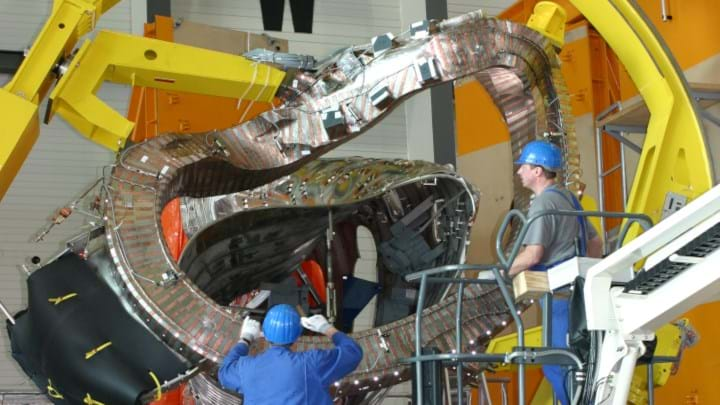Fusion industry heavyweights team up to advance fusion technology

Fusion industry heavyweights are teaming up to advance fusion technology in a bid to further clean and sustainable energy. Announced on the same day, these new deals include a partnership between General Atomics (GA) and Tokamak Energy on high temperature superconducting (HTS) technology for fusion energy. Separately, the Max Planck Institute for Plasma Physics and Proxima Fusion will work on the stellarator concept for fusion power.
Headquartered in the US, GA has teamed up with UK-headquartered Tokamak Energy to collaborate on HTS magnet technologies.
HTS magnets are key to fusion production in tokamaks – machines that confines a superheated hydrogen gas known as plasma, in a donut or torus shape, using several sets of powerful electromagnets.
To achieve fusion conditions relevant for energy production, tokamaks must heat the gas to temperatures exceeding 100m degrees Celsius – more than 10 times the temperature at the centre of the sun – and it must be kept hot. To insulate plasma from ordinary matter, fusion devices make use of the fact that charged particles react to magnetic forces, and use the magnetic fields generated from the magnets to constantly spin the particles around their torus-shaped reactor chambers to prevent them from escaping the plasma. The stronger the magnetic field, the stronger the confining force on the charged particles in the plasma, and the better the insulation.
The fusion process, whereby two light nuclei merge to form a single heavier nucleus, is so potent that it could generate four times more energy per kilogram of fuel than fission (used in nuclear power plants) and nearly four million times more energy than burning oil or coal. And it does so without producing any carbon emissions or long-lasting waste, hence the appeal to harness it.
Tokamak Energy is working on improving HTS magnet technology by replacing traditional magnet materials like copper, which creates unwanted overheating due to its electrical resistance, with superconducting materials that have zero electrical resistance when cooled to –269°C.
Tokamak Energy said in its next spherical tokamak, it will use groundbreaking HTS tape. When wound into specialist coils, the tape generates much stronger magnetic fields, takes up less space, and requires five times less cooling power.
Discussing the collaboration with GA, Warrick Matthews, managing director at Tokamak Energy, said the partnership would make use of GA’s capabilities for manufacturing large-scale magnet systems and Tokamak’s “pioneering expertise” in HTS magnet technologies. The integration of these complementary capabilities also promises “to accelerate the development and production of HTS technologies in additional fields, such as aviation, naval, space and medical applications,” Matthews said.
Going stella
Opting for an alternative fusion route, the Max Planck Institute for Plasma Physics (IPP) will work with Proxima Fusion, the first spin-out company in the history of the IPP, to further develop the stellarator concept.
Stellarators are similar to tokamaks in that they use magnetic confinement devices to manipulate plasmas, but whereas tokamaks induce electric currents inside the plasma, stellarators use external coils to generate a twisting magnetic field to control the plasma.
Though both reactor types have certain advantages, stellarators may offer a better alternative to producing fusion energy, as they are better at keeping plasmas stable, and require less injected power to sustain the plasma compared with tokamaks, the IAEA notes.
However, making stellarator coils is a challenge due to their increased complexity as it requires manufacturers to construct large bore wire coils with millimetre precision. As such, working tokamaks outnumber stellarators by about six to one.
IPP currently operates both; its tokamak is located in Garching near Munich IPP, and its Wendelstein 7-X stellarator is in Greifswald in the northeast of Germany.
The institute said its Wendelstein 7-X (W7-X) is the world's most modern and powerful stellarator experiment, and that earlier this year, it succeeded for the first time in generating a high-energy plasma that lasted for eight minutes. IPP said the testing facility is working towards generating plasma discharges of up to 30 minutes in the coming years.
Building on decades of experience with the W7-X, Proxima Fusion said that along with IPP, the group aims to deploy a new, high-performance stellarator over the coming years, with a first-of-a-kind fusion power plant expected within the 2030s.
Francesco Sciortino, co-founder and CEO of Proxima Fusion explained: "Experimental progress from W7-X and recent advances in stellarator modelling have radically changed the picture. Stellarators can now remedy the key problems of tokamaks and truly scale up, radically improving the stability of the plasma and reaching high performance in steady state.”
The IPP has also signed a cooperation agreement with the US company Commonwealth Fusion Systems, and shared letters of intent for a possible cooperation with the start-ups Gauss Fusion and Type One Energy. All are to capitalise on IPP’s knowledge of fusion power plants.
Recent Editions
Catch up on the latest news, views and jobs from The Chemical Engineer. Below are the four latest issues. View a wider selection of the archive from within the Magazine section of this site.




